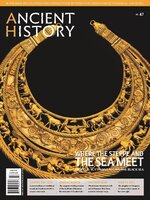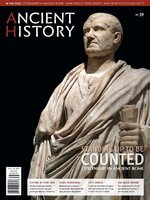Ancient History looks at every aspect of the ancient world: you'll find articles covering politics, society, literature, language, religion, economics, and art - all in one magazine! Like its big brother, Ancient Warfare, Ancient History Magazine is a bi-monthly, 60-page magazine that relies on a thematic approach: each issue is centered around one specific subject. From ancient Egyptian trade and Roman family life to the lost city of Pompeii, there's sure to be something for everyone - all presented in a well-researched but accessible, fun manner.
ANCIENT HISTORY
EDITORIAL - THE MYSTERY OF THE CELTS…
FROM CYPRUS TO SWEDEN • It may come as a surprise that one of the world’s most significant collections of Cypriot art and archaeology is actually located in Sweden. Stockholm’s Medelhavsmuseet (The Museum of Mediterranean and Near Eastern Antiquities) houses the archaeological excavations from the Swedish Cyprus Expedition of 1927-1931. Formally opened to the public in 1953, the museum’s Cypriot collection consists of around 1,500 objects spanning a period of more than 7,000 years – from the island’s prehistoric era to imperial Rome. We uncover the story behind this landmark archaeological expedition and Sweden’s unparalleled collection of Cypriot antiquities in an interview with Dr. Giorgos Bourogiannis.
LEARNING FROM NUMISMATICS • I always dreamt of being an archaeologist. Ever since I was a child, I wanted to dig and dreamt of finding pots, jewellery, and glistening gold coins. I began my career working for Wessex Archaeology and it was while working there that I discovered my first Roman coin. It wasn’t exactly glistening, more caked in thick clay and almost swimming in the waterlogged trench, but it remains, to this day, one of the highlights of my career. I can still remember the exact coin: it was a Roman denarius bearing the head of Faustina II, struck under Marcus Aurelius (AD 161-180). I have excavated dozens since, but that first coin was very special.
WHO WERE THE CELTS? • Classical sources speak of kings, nobles, knights, bards, and druids when discussing the ancient Celts of the European Iron Age. Yet, historical sources informing us about the makeup of ancient Celtic societies are sparse, and most of what we can say about how these societies worked must be reconstructed from archaeological finds and features. Archaeology shows us that across space and time, there were considerable if not even vast differences between different Celtic societies: their organization may have ranged from largely egalitarian, nearly democratic ones via oligarchies to almost absolutist, feudal monarchies.
FRAGMENTING THE CHIEFTAIN • Some 3000 years ago, a man living in what is now the south of the Netherlands died. He was about 30-40 years old and must have been an impressive sight when alive. His muscles were well-developed from heavy use – perhaps from reining in the large horses who pulled his wagon and from training with swords – and he was very tall for the time. As was customary in the Early Iron Age in his region, his body was cremated and interred in an urn.
What’s in a name?
A ride fit for a king (or chieftain)
THE CELTS AT WAR • On a fateful day sometime between 390 and 385 BC, an armed band of Gauls entered the city of Rome and set fire to it. The terror of that traumatic event haunted the Romans for centuries. In Greece and Asia Minor too, these fighters were much feared. Stories were told of the tall, strong, long-haired Celtic Übermenschen who dispensed with body armour and, instead, fought naked. But is there truth to these tales, and did these warriors deserve their fearsome reputation?
A SLAVE IN EXCHANGE FOR A DRINK • From the Bronze Age to the Middle Ages, feasting and merriment was serious business in Celtic Europe. The act of gathering, especially for the ritual consumption of...

 AH 57
AH 57
 AH 56
AH 56
 AH 55
AH 55
 AH 54
AH 54
 AH 53
AH 53
 AH 52
AH 52
 AH 51
AH 51
 AH 50
AH 50
 AH 49
AH 49
 AH 48
AH 48
 AH 47
AH 47
 AH 46
AH 46
 AH 45
AH 45
 AH 44
AH 44
 AH 43
AH 43
 AH 42
AH 42
 AH 41
AH 41
 AH 40
AH 40
 AH 39
AH 39
 AH 38
AH 38